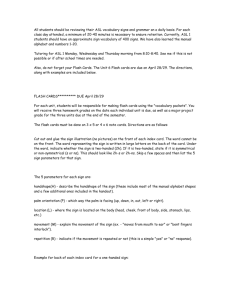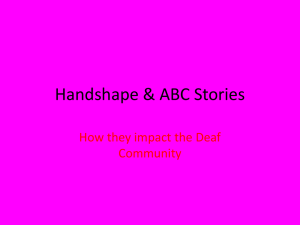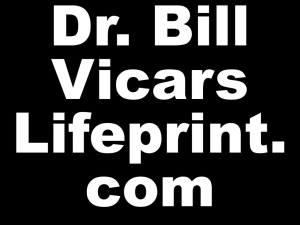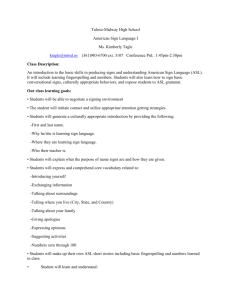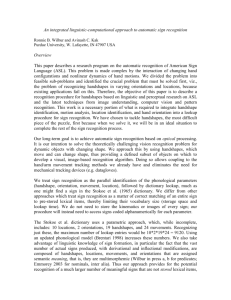Study Cards ()
advertisement
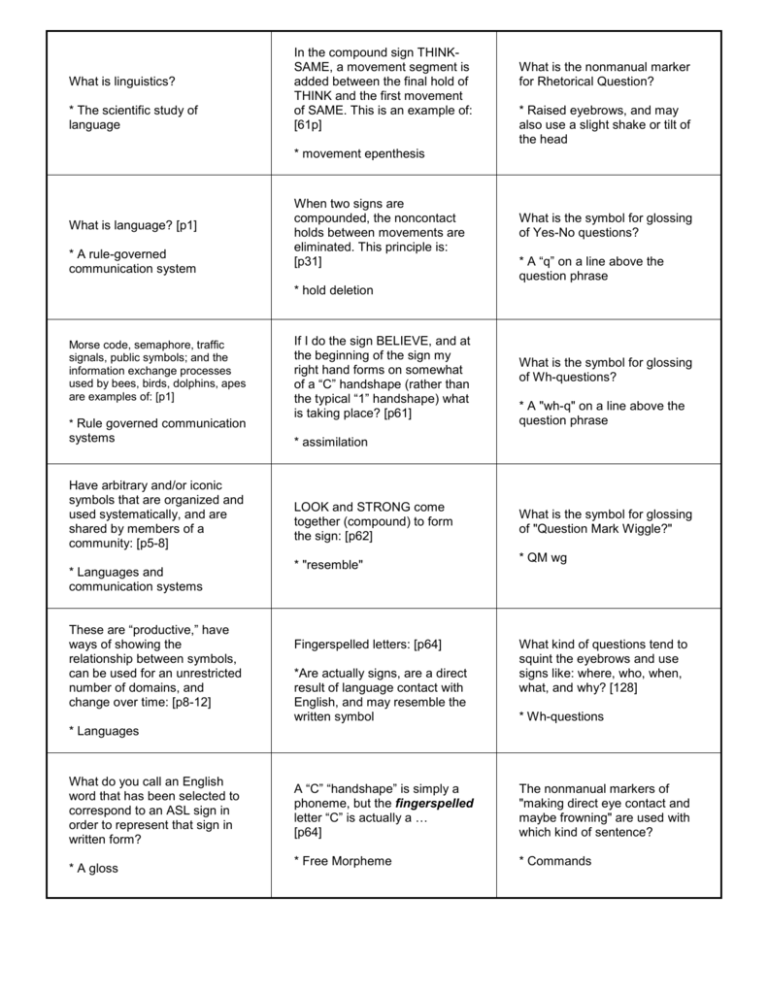
What is linguistics? * The scientific study of language In the compound sign THINKSAME, a movement segment is added between the final hold of THINK and the first movement of SAME. This is an example of: [61p] What is the nonmanual marker for Rhetorical Question? * Raised eyebrows, and may also use a slight shake or tilt of the head * movement epenthesis What is language? [p1] * A rule-governed communication system When two signs are compounded, the noncontact holds between movements are eliminated. This principle is: [p31] What is the symbol for glossing of Yes-No questions? * A “q” on a line above the question phrase * hold deletion Morse code, semaphore, traffic signals, public symbols; and the information exchange processes used by bees, birds, dolphins, apes are examples of: [p1] * Rule governed communication systems Have arbitrary and/or iconic symbols that are organized and used systematically, and are shared by members of a community: [p5-8] * Languages and communication systems These are “productive,” have ways of showing the relationship between symbols, can be used for an unrestricted number of domains, and change over time: [p8-12] If I do the sign BELIEVE, and at the beginning of the sign my right hand forms on somewhat of a “C” handshape (rather than the typical “1” handshape) what is taking place? [p61] What is the symbol for glossing of Wh-questions? * A "wh-q" on a line above the question phrase * assimilation LOOK and STRONG come together (compound) to form the sign: [p62] * "resemble" Fingerspelled letters: [p64] *Are actually signs, are a direct result of language contact with English, and may resemble the written symbol What is the symbol for glossing of "Question Mark Wiggle?" * QM wg What kind of questions tend to squint the eyebrows and use signs like: where, who, when, what, and why? [128] * Wh-questions * Languages What do you call an English word that has been selected to correspond to an ASL sign in order to represent that sign in written form? * A gloss A “C” “handshape” is simply a phoneme, but the fingerspelled letter “C” is actually a … [p64] The nonmanual markers of "making direct eye contact and maybe frowning" are used with which kind of sentence? * Free Morpheme * Commands What do you call the principle that states that in a two-handed sign, if both hands move, then they will have the same handshape and type of movement? [p3] * The symmetry condition What do you call the principle that states that in a two-handed sign, if each hand has a different handshape, then only the active hand can move; the passive hand serves as a base and does not move. [p3] In fingerspelling, a number of separate morphemes may begin to act like one single morpheme. When this happens the result is called: [p64] * Lexicalized fingerspelling When glossing we use the symbol # to indicate: [p64] * Lexicalized fingerspelling What is the Wh-question nonmanual marker? * Squint eyebrows, and may also: tilt head, lean slightly forward, or hunch shoulders What do we sometimes use at the end of a question when signer is surprised? [p129] * Question Mark Wiggle * The dominance condition What are the seven basic handshapes used by the passive hand in a two-handed sign. (Note “G” and “1” are considered the same handshape.) [p3] When a fingerspelled word becomes lexicalized, the location, handshapes, and orientation may change. Letters may be deleted. Movement may be added. Which of the following isn’t one of the changes that sometimes takes place in lexicalized fingerspelling? [p64-67] Each letter may begin to act as a separate morpheme * * A, B, C, G, O, S, and 5. What term means that the actual form of a symbol doesn’t reflect the form of the thing or activity it symbolizes? [p5] Lexicalized means: [p68] * “Like a word” Look like questions but the signer doesn’t expect an answer. [p129] * Rhetorical Questions The gloss for a rhetorical question is: [p130] * “rhet” * Arbitrary What term means that the form of a symbol is an icon or picture of some aspect of the thing or activity being symbolized? [p5] * Iconic What do you call it when the sound of a word symbolizes the sound of the object or activity to which the word refers? [p5] When two languages are in contact, then tend to borrow from each other. ASL borrows from other sign languages. The signs that are borrowed from one language to another are called: [p69] It is common to do these signs: WHEN, WHO, WHAT, WHERE, FOR-FOR, and REASON with raised eyebrows in what type of question? [p130] * Loan Signs * Rhetoricals Quite a few of the indigenous signs used by people in other countries to refer to their country have been adopted by ASL users to refer to those countries. For example, instead of using the former ASL signs for JAPAN, ITALY, CHINA, and AUSTRALIA, we now use the signs used by each of those countries. These signs are: [p69] The process of changing an affirmative sentence to a negative is called: [p131] * Onomatopoeia * Loan Signs * negation What do you call groups of words that resemble each other and whose form seems to reflect their meaning? [p5] * Phonesthesia. What are the three main communication domains of animals? [p10] Meaningful units of language that cannot occur alone are called: [p72] * Bound morphemes Signs are composed of various parameters and articulatory features. Which of the following is not a parameter or articulatory feature of signs? * mating, danger, food What do we call it when the object of the sentence is moved to the front of the sentence? [p131] * Topicalization What is a lexical item? (135) * A lexical item is basically a “word” (Or a “sign”) * Glosses Who established the Connecticut Asylum for the Education and Instruction of Deaf and Dumb? (Which was later changed to the American School for the Deaf). [p14] In the sign WEEK, you can change the handshape from a 1 to a 2, or a 3 and so on to mean a specified number of weeks. This process in ASL is known as: [p72] * tense markers * Thomas Hopkins Gallaudet and Laurent Clerc * Numerical incorporation What term refers to the various sign systems that were developed to represent English on the hands? [p14] The sign “TWO-WEEKS” can be thought of as having two meaningful parts. The first part would be the bundle of information consisting of the holds, movement, location, orientation, and nonmanual signal. What is the other meaningful part? [p73] * Manually Coded English (MCE) (According to the text) In spoken languages, do smaller gestures combine to form larger gestures? [p15] In the sign “TWO-WEEKS” the “2 handshape”: [p74] * Is a bound morpheme * compounding In English “s” and “ed” are: (135) * Bound morphemes * The handshape * No “Language contact” like what happened at Deaf Way is an avenue or process of introducing new symbols into ASL. Name another process for introducing new symbols that also begins with the letter “c.” [p.9] When discussing "time" in linguistics, the special morphemes in English “s” and “ed” are called: For most native signers, the handshape for WEEK can be changed from 1 through: [p74] * nine The number handshape in signs that use numerical incorporation is a: (136) * Bound morpheme Is there really an imaginary time line that we use in ASL? * Yes –it runs perpendicular to your body (from behind you to in front of you -- going off into the distance both ways). In ASL you wouldn’t use a preposition such as “on” to indicate a book is on a table. What would you use instead? [p.9] The handshape change that we see in “ages 1 to 9” is the result of: [p74] * phonological assimilation * classifier predicate What nonmanual signal uses pouted lips with the tongue visibly positioned between the teeth and can be translated as meaning “carelessly?” [p.8] In the sign LOUSY, its individual parts: [p74] * do not have independent meaning * “th” The study of how the meaning conveyed by a word or sentence depends on aspects of the context in which it is used (such as time, place, social relationship between speaker and hearer, and speaker’s assumptions about the hearer’s beliefs). [p2] In the signs SUMMER, UGLY, and DRY, space is used to indicate what kind of contrast? [p77] Name some common time signs discussed in the chapter that are only partly related to the timeline: (136) * YESTERDAY, TOMORROW, NOT-YET, RECENTLY Name the time signs identified in the book as being strongly linked to the time line: (136) * UP-TILL-NOW AND FROMNOW-ON Name some time signs that (according to the authors) signing further out on the timeline serves only to emphasize the concept. * phonological * NOW, TODAY, LATER, LONG-TIME-AGO, and FUTURE The application of the methods and results of linguistics to such areas as language teaching; national language policies; lexicography; translation; and language in politics, advertising, classrooms, courts, and the like. [p2] The sentences “I GIVE YOU” and “YOU GIVE ME” makes what kind of use of space? [p77] Name some time signs that allow numerical incorporation: (137) * Applied Linguistics * morphological The study of the way in which words are constructed out of smaller meaningful units. [p2] If I use movement and space to show that someone is “giving” continually or over and over again, what kind of marker am I using? [p77] * Pragmatics * Morphology * aspectual The study of meaning; how words and sentences are related to the objects they refer to and the situations they describe. [p2] * Semantics When a location in space is associated with a nominal, it performs what kind of function? [p77] * referential * MORNING, AFTERNOON, NIGHT, NOON, MIDNIGHT, DAY, MINUTE, TIME Name some signs that can use location and/or orientation to indicate units of time in the past or the future. (137) * WEEK, YEAR EVERY-WEEK, EVERYMORNING, and EveryMONDAY Are examples of 137 * Habitual time The study of the brain and how it functions in the production, perception and acquisition of language. [p2] * Neurolinguistics What do we call the smallest contrastive units of language? [p19] * Phonemes What term do sign language linguists use to refer to the study of how signs are structured and organized? [p19] When you use space to provide information about the location of a person or object in a threedimensional network, what sort of function are you using? [p77] * locative A good example of a signer describing something using a “relative frame of reference” would be: [p77] * Signing a scene from his or her perspective. A good example of a signer is describing something using an “absolute frame of reference” would be: [p77] * Phonology * Giving directions using the standard signs EAST, WEST, NORTH, and SOUTH. What are the five basic parts of signs? [p19] A good example of a signer is describing something using an “narrative perspective” would be: * handshape, movement, location, orientation, nonmanual signals * A phrase in which the person takes on the role of one of the characters as if he were actually that person. [p77] What term means choosing an appropriate English word for signs in order to write them down? [p21] Location can have independent meaning in ASL Signs. [p76] * TRUE * Glossing What kind of features are indicated on a line above sign glosses? [p21] * Nonmanual features Locative verbs [p79] * The direction or location of the sign contains specific meaning What time signs (according to the author) can commonly be used as an exclamation point? (137) * WILL, FINISH What is “semantics?” (138) * The study of the meaning of words and sentences. Sign Language Dictionaries (142) * Are almost necessarily bilingual How was Stokoe’s Dictionary of American Sign Language was different from most other sign language dictionaries? (142) * It presented signs by the parameters of location, handshape. Includes information about the signer’s feelings, attitudes, or opinions [143] * Affective Meaning Includes information about the identity of the language user [142] * Social Meaning When glossing, what do we use “small capital letters in English” to represent? [p21] * Signs When glossing, what do we represent with small capital letters preceded by the # symbol? [p21] * lexicalized fingerspelled words When glossing, what is represented by dashes between small capital letters? [p21] * full fingerspelling Plain verbs: [p76] * The function of location is articulatory One difference between locative verbs and classifier predicates is that: [p79] The idea, thing, or state of affairs described [142] * Referential Meaning The social and affective meaning of a sign is often called its [143] * The handshape in locative verbs doesn’t have independent meaning * Connotation Verbs that include information about two subjects and two objects simultaneously such as the verb "LOOK-AT-EACHOTHER" are best described as: [p78] Referential meaning of a sign is often called its [143] * Denotation * reciprocal verbs Name two systems that have been developed for describing the structure of signs. [p22] * “The Stokoe system” and the “The Liddell and Johnson system” What do we call the agreedupon symbols that linguists use to describe the structure of signs in a consistent and predictable manner? [p22] Plain verbs: [p76] * The function of location is articulatory "I give to you" is best described as what kind of verb: [78] * indicating verb The collection of words or signs that users of a language know is called the [144] * Lexicon The study of the rule governed ways in which languages structure meaning [141] * Semantics * Conventions William C. Stokoe designed the first system for describing ASL. His system claimed that signs consisted of three cheremes [parameters or parts). What were the parts? [p26] * tab – location, dez – handshape, and sig – movement Verbs that contain information related to action or state of being and/or that convey information about certain aspects of their meaning such as showing where things are in space, showing what things look like, and/or showing how things move are best described as: [80] * depicting verbs The rules for making sentences [113] * Syntax The Stokoe system of describing ASL is limited in its usefulness as a description system. Stokoe’s system provides an insufficient The linguistic term for verbs or predicates that do not allow objects is: [p83] The prefix "hypo-" means [144] * below * Intransitive * See Page 26-30 What model for describing the structure of signs did Scott K. Liddell and Robert E. Johnson develop? [p37] The term for verbs that allow objects is: [p84] * Transitive * The Movement-Hold Model According to the MovementHold Model, signs consist of hold segments and movement segments that are produced: [p37] The relationship between "hand" and "arm" is best described as [144] * Part/Whole The basic word order in ASL for sentences is: [p84] Gradable and nongradable are two types of [145] * Subject-Verb-Object * Antonymy There are at least six possible movement hold combinations, which one is not used? [p38] In languages that do not use the verb "to be" a predicate may consist of: [p90] "If/then" relationships such as teacher and student [147] * HM * verbs, nouns, or adjectives The Liddell and Johnson system claims that the basic units of signs are produced: [p40] A classifier is: [p91] * sequentially An extension of the use of a word beyond its primary meaning [148] * A symbol for a class of objects * Metaphor * sequentially Stokoe claimed that parameters of signs were produced:[p40] * Converseness A classifier, when combined with location, orientation, movement, and nonmanual signals, forms a [p91] * simultaneously Orientational, ontological, and structural are types of [148] * Metaphor * classifier predicate Linguists’ have come up with varying numbers of “primes” for sign parameters (handshapes, locations, orientations, movements, holds, and nonmanual signals). How many primes did Stokoe count? [p40] Name two basic parts of classifier predicates: [p92] * the movement root and the handshape The relationship between two signs that are opposite in meaning [145] * Antonymy * nineteen Linguists’ have come up with varying numbers of “primes” for sign parameters (handshapes, locations, orientations, movements, holds, and nonmanual signals). How many did Liddle and Johnson count? [p40] Name three kinds of movement roots: [p92] * Stative descriptive, process, contact What are the "semantic roles" played by signs in a sentence? [152] * Agent, Patient, Experiencer, Instrument, and Cause * more than 150 What is the segmental structure of CHAIR? [p40] The signed concept “MOUND OF RICE” would fall into which of the following classifier types or movement roots: [p92] * MMMH * Stative descriptive Sometimes a movement segment is added between the last segment of one sign and the first segment of the next sign. The process of adding a movement segment between two signs is called: [p42] In the sentence: CAT CHASE DOG, the sign "CAT" fills which semantic role? * Agent The signed concept “TREESGO-BY” would fall into which of the following classifier types or movement roots: [p92] In the sentence: TREES, TORNADO DESTROY, the sign "TORNADO" fills which semantic role? * Process * cause The elimination of holds between movements of signs that occur in sequence is called: [p42] The signed concept “PILE-OFCOINS” would fall into which of the following classifier types or movement roots: [p92] We use "function words or morphemes" to indicate * hold deletion * Stative descriptive Sometimes parts of the segments of a sign can change places. This is called: [p44] The signed concept “CAT-SIT” would fall into which of the following classifier types or movement roots: [p92] * movement epenthesis * metathesis * Contact root * Tense, Aspect, Reference, Deixis ASL tends to indicate tense by: * Adding separate lexical items and/or using the location of the hands relative to the body, or leaning. The signs DEAF, CONGRESS, FLOWER, RESTAURANT, HONEYMOON, NAVY, TWINS, BACHELOR, PARENTS, HOME, and HEAD can all use this phonological process: [p44] To show a crowd of people you would use the sign “SCADS OF.” What type of classifier handshape is “SCADS OF?” [p93] * metathesis * on surface morpheme This phonological process occurs when a segment takes on the characteristics of another segment near it: [p46] What type of classifier handshape is the sign “FLAT TIRE?” [p93] * assimilation Consonants and vowels in spoken languages are parallel to what in sign languages? [p48] * holds and movements What is the study of the smallest contrastive parts of language that do not have independent meaning? [p51] * phonology In considering phonology and morphology, which of the following signs doesn’t fit with the other on the list? [p52] * THREE-DOLLARS (In this sign, the three handshape functions as a morpheme] In English, adding “er” to the term “walk” to create “walker” is an example of: [p54] * using a form morpheme to create a noun from a verb The manner in which the action of a verb is performed has to do with [154] * Aspect If we alter the basic structure of the sign SIT to mean: "SITFOR-A-LONG-TIME" we are using what type of function morpheme? * extent morpheme * Aspect A movement root and a classifier handshape combine to form: [p93] * A classifier predicate Which term most closely refers to the process whereby the meanings of the small units get lost in the meaning of the large unit? [p95] * Lexicalization Productive classifier predicates: [p96] * Each part of the sign has independent meaning. Lexicalized classifier predicates: [p97] * The parts of the sign do not have independent meaning Provides information about the relationship between noun phrases and their referents [154] * Reference The difference in meaning between "The man is silly" and "A man is silly" is due to the use of * A determiner Marks the orientation or position of objects and events with respect to certain points of reference. * Deixis The area of linguistics that investigates the role of context in understanding meaning. [155] * Pragmatics In English, emphasizing or “stressing” the first syllable of the word subject instead of the second syllable, is an example of: [p54] * using a process morpheme to create a noun from a verb What types of signs differ in their movement but share the same handshape, location, and orientation? [p54] * noun-verb pairs The process of repetition is called: [p55] * reduplication The process of adding bound morphemes to other forms to create new units is called: [p55] * affixation The use of affixation in ASL would result in the creation of a: [p54-56 “read for understanding”] * form morpheme Noun-verb pairs provide an example of: [p54-56 “read for understanding”] * creation of a process morpheme The linguistic term for adding grammatical information to a word or sign: [p105] What do we call the study of the interrelationship of language and social structure? [161] * Inflection * Sociolinguistics When the signing space for a sign is reduced and the movement is done quickly it inflects the meaning of a verb to mean: [p107] When a user of a language knows how to use language for both communicative and social functions he or she is said to be * IN-A-HURRY For a sign like “ANALYZE,” the meaning of “IN-A-HURRY” can be indicated with: [p107] * inflection of the internal movement of the fingers Another temporal aspect marker is “activity performed under pressure and then concluded.” This can be shown by: [p108] * Signing with the lips parted and tense, the eyes squinted, and then the mouth drops open and the eyes relax The sign ARRIVE (M H) can be produced with an added initial hold (H M H) to mean ARRIVE-AT-LAST OR ARRIVE-FOLLOWING-SOMEDELAY. The added initial hold is essentially an: [p108] * communicatively competent Regional variation at the phonological level is referred to as what? * Accent This person graduated Gallaudet College, was a respected teacher and leader in the Deaf community, served two terms as president of the NAD and in 1913 gave a speech that came to be known as "Preservation of the Sign Language." * Veditz Use of language that goes beyond the sentence * discourse [169] * affix The process of making new units for a language is typically described as: [p110] * Derivational morphology Apologizing, warning, threatening, commanding, requesting, recognizing someone's existence, and striving to control other's behavior are examples of: * Functions of language: The creation of a new word by combining two free morphemes is called: [p58] * compounding Making nouns from verbs (noun/verb pairs), compounding, lexicalized fingerspelling, numerical incorporation, classifier predicates, and perspective verbs, are all examples of: [p110] Storytelling, poetry, ABC games, and number games are examples of: * Language as Skilled Work: * Derivational morphology The first contact rule applies to: [p59] * compounds When compounds are made in ASL, internal movement or the repetition of movement is eliminated. This principle is called: [p60] The process of adding grammatical information to units that already exist is: [p111] * Inflectional morphology * The Norms and Structure of Language Use Changing the verb “SIT” to mean the noun “CHAIR” is an example of a [p110] Used in conversations to tell someone about a conversation that has already taken place (“He said …then she said…”) * Derivational process * The simple sequence rule When a right handed signer signs the concept “BELIEVE,” (which is made up from the signs “THINK” and “MARRY”) his left hand is formed into a “C” handshape while the right hand is signing “THINK.” This is an example of: [p60] How many people can talk at once, how much should one person sign, what can be signed about, and turn taking: Changing the verb “SIT” to mean "sit for a long time" is an example of a [p111] *Constructed Dialog (Role Shift) The setting in which discourse takes place (formal vs informal) and choosing language appropriate for certain occasions * Inflectional Process * Register Variation [172] * weak hand anticipation rule Movement epenthesis, hold deletion, and assimilation are what kind of rules? [p61] * Phonological rules The first contact rule, the simple sequence rule, and the weak hand anticipation rule are what kind of rules [p59] * morphological rules Which of the following sentence types isn't marked by any particular nonmanual signal? [p127] Consideration of using a first name vs using a formal title would be an example of what aspect of discourse analysis? * declarative * Social Identity What is the nonmanual marker for Yes-No Questions? [p127] Colonialism, military invasions, social economic reasons, nationalism, education, urbanization, and intermarriage are common reasons for: * raise eyebrows , and might also: tilt head, lean body forward, raise shoulders, hold last sign longer * Bilingualism Fingerspelling, I have “cha” homework, mouthing of English words, lexicalized mouthing and code switching between ASL and SEE are examples of: *Unique phenomena Pizza and spaghetti (in English) as well as AUSTRALIA ITALY JAPAN CHINA (in ASL) are examples of: * Lexical borrowing _
